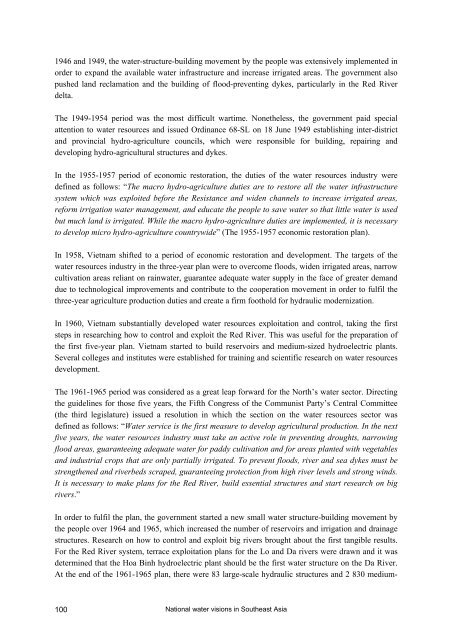The FAO-ESCAP pilot project on national water visions. From vision ...
The FAO-ESCAP pilot project on national water visions. From vision ...
The FAO-ESCAP pilot project on national water visions. From vision ...
Create successful ePaper yourself
Turn your PDF publications into a flip-book with our unique Google optimized e-Paper software.
1946 and 1949, the <strong>water</strong>-structure-building movement by the people was extensively implemented in<br />
order to expand the available <strong>water</strong> infrastructure and increase irrigated areas. <str<strong>on</strong>g>The</str<strong>on</strong>g> government also<br />
pushed land reclamati<strong>on</strong> and the building of flood-preventing dykes, particularly in the Red River<br />
delta.<br />
<str<strong>on</strong>g>The</str<strong>on</strong>g> 1949-1954 period was the most difficult wartime. N<strong>on</strong>etheless, the government paid special<br />
attenti<strong>on</strong> to <strong>water</strong> resources and issued Ordinance 68-SL <strong>on</strong> 18 June 1949 establishing inter-district<br />
and provincial hydro-agriculture councils, which were resp<strong>on</strong>sible for building, repairing and<br />
developing hydro-agricultural structures and dykes.<br />
In the 1955-1957 period of ec<strong>on</strong>omic restorati<strong>on</strong>, the duties of the <strong>water</strong> resources industry were<br />
defined as follows: “<str<strong>on</strong>g>The</str<strong>on</strong>g> macro hydro-agriculture duties are to restore all the <strong>water</strong> infrastructure<br />
system which was exploited before the Resistance and widen channels to increase irrigated areas,<br />
reform irrigati<strong>on</strong> <strong>water</strong> management, and educate the people to save <strong>water</strong> so that little <strong>water</strong> is used<br />
but much land is irrigated. While the macro hydro-agriculture duties are implemented, it is necessary<br />
to develop micro hydro-agriculture countrywide” (<str<strong>on</strong>g>The</str<strong>on</strong>g> 1955-1957 ec<strong>on</strong>omic restorati<strong>on</strong> plan).<br />
In 1958, Vietnam shifted to a period of ec<strong>on</strong>omic restorati<strong>on</strong> and development. <str<strong>on</strong>g>The</str<strong>on</strong>g> targets of the<br />
<strong>water</strong> resources industry in the three-year plan were to overcome floods, widen irrigated areas, narrow<br />
cultivati<strong>on</strong> areas reliant <strong>on</strong> rain<strong>water</strong>, guarantee adequate <strong>water</strong> supply in the face of greater demand<br />
due to technological improvements and c<strong>on</strong>tribute to the cooperati<strong>on</strong> movement in order to fulfil the<br />
three-year agriculture producti<strong>on</strong> duties and create a firm foothold for hydraulic modernizati<strong>on</strong>.<br />
In 1960, Vietnam substantially developed <strong>water</strong> resources exploitati<strong>on</strong> and c<strong>on</strong>trol, taking the first<br />
steps in researching how to c<strong>on</strong>trol and exploit the Red River. This was useful for the preparati<strong>on</strong> of<br />
the first five-year plan. Vietnam started to build reservoirs and medium-sized hydroelectric plants.<br />
Several colleges and institutes were established for training and scientific research <strong>on</strong> <strong>water</strong> resources<br />
development.<br />
<str<strong>on</strong>g>The</str<strong>on</strong>g> 1961-1965 period was c<strong>on</strong>sidered as a great leap forward for the North’s <strong>water</strong> sector. Directing<br />
the guidelines for those five years, the Fifth C<strong>on</strong>gress of the Communist Party’s Central Committee<br />
(the third legislature) issued a resoluti<strong>on</strong> in which the secti<strong>on</strong> <strong>on</strong> the <strong>water</strong> resources sector was<br />
defined as follows: “Water service is the first measure to develop agricultural producti<strong>on</strong>. In the next<br />
five years, the <strong>water</strong> resources industry must take an active role in preventing droughts, narrowing<br />
flood areas, guaranteeing adequate <strong>water</strong> for paddy cultivati<strong>on</strong> and for areas planted with vegetables<br />
and industrial crops that are <strong>on</strong>ly partially irrigated. To prevent floods, river and sea dykes must be<br />
strengthened and riverbeds scraped, guaranteeing protecti<strong>on</strong> from high river levels and str<strong>on</strong>g winds.<br />
It is necessary to make plans for the Red River, build essential structures and start research <strong>on</strong> big<br />
rivers.”<br />
In order to fulfil the plan, the government started a new small <strong>water</strong> structure-building movement by<br />
the people over 1964 and 1965, which increased the number of reservoirs and irrigati<strong>on</strong> and drainage<br />
structures. Research <strong>on</strong> how to c<strong>on</strong>trol and exploit big rivers brought about the first tangible results.<br />
For the Red River system, terrace exploitati<strong>on</strong> plans for the Lo and Da rivers were drawn and it was<br />
determined that the Hoa Binh hydroelectric plant should be the first <strong>water</strong> structure <strong>on</strong> the Da River.<br />
At the end of the 1961-1965 plan, there were 83 large-scale hydraulic structures and 2 830 medium-<br />
100<br />
Nati<strong>on</strong>al <strong>water</strong> visi<strong>on</strong>s in Southeast Asia
















